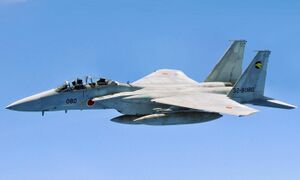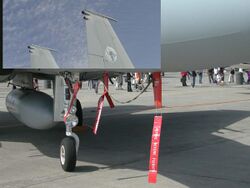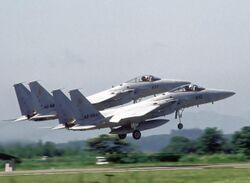Engineering:Mitsubishi F-15J
| F-15J | |
|---|---|

| |
| A Japan Air Self-Defense Force F-15DJ | |
| Role | Air superiority fighter |
| National origin | Japan United States |
| Manufacturer | Mitsubishi Heavy Industries McDonnell Douglas |
| First flight | 4 June 1980 |
| Introduction | 7 December 1981 |
| Primary user | Japan Air Self-Defense Force |
| Number built | 213[1] |
| Developed from | McDonnell Douglas F-15 Eagle |
The Mitsubishi F-15J/DJ Eagle is a twin-engine, all-weather air superiority fighter based on the McDonnell Douglas F-15 Eagle in use by the Japan Air Self-Defense Force (JASDF). The F-15J was produced under license by Mitsubishi Heavy Industries. The subsequent F-15DJ and F-15J Kai variants were also produced. Japan is the largest customer of the F-15 Eagle outside the United States.[2] In addition to combat, F-15DJ roles include training. The F-15J Kai is a modernized version of the F-15J.[3][4]
Development
In June–July 1975, the Japan Defense Agency (JDA, now Ministry of Defense) examined the McDonnell Douglas F-15 Eagle as one of the 13 candidates for the replacement of the F-104J/DJ Starfighter and F-4EJ Phantom II. A single-seat F-15C and a twin-seat F-15D were evaluated at Edwards Air Force Base, and in December 1975, the F-15 was announced the winner, with the government intending to purchase 187 F-15J/DJs. By April 1978, Mitsubishi Heavy Industries was designated as the primary contractor and licensing for the F-15C/D was achieved.[5][6]
After congressional review, the Department of Defense (DoD) withheld the aircraft's electronic warfare and engine systems from the licensing. Initially, the aircraft were produced in the U.S. and exported to Japan. This initial export production contributed to aircraft development under the defense industry of Japan while facilitating base production of aircraft, achieving the goal of producing a fighter to Japan's requirements.[7]
The Japan Air Self-Defense Force (JASDF) acquired 203 F-15Js and 20 F-15DJs, of which 2 F-15Js and 12 F-15DJs were built by McDonnell Douglas in St. Louis, Missouri.[5] Dubbed the "Peace Eagle" by the DoD FMS program, the first F-15J built in St. Louis was delivered to the United States Air Force for its first flight on 4 June 1980, and a subsequent cruise on 15 July to Japan. Additionally, 8 F-15Js were manufactured in large components and shipped to Japan for final assembly by Komaki of Mitsubishi, the first of these (serial number 12–8803) making its maiden flight on 26 August 1981.[5][8] Companies divided the remainder share and produced it under license from 1981, with final assembly of aircraft performed by Mitsubishi.[5]
In the latter period of 1981, the first F-15J/DJ aircraft were sent to 202nd Tactical Fighter Squadron, which was reorganized as an Eagle FTU and renamed the 23 Flying Training Squadron at Nyutabaru base on 21 December 1982. The JASDF developed a plan to form the first squadron after the KAL007 shootdown by a Soviet Su-15 on 1 September 1983. In March 1984, new F-15Js began replacing the 203rd Tactical Fighter Squadron's F-104Js at Chitose Air Base, located across the La Pérouse Strait from the Soviet fighter base on Sakhalin Island.[5]
On 24 December 2018, it was announced that Japan is considering selling their F-15s to the U.S. in order to acquire funds to purchase F-35s.[9]
The Japanese Ministry of Defense confirmed on February 4, 2022 that 68 F-15Js will be upgraded through the Japan Super Interceptor (JSI) programme under a cost of JPY646.5 billion (USD5.6 billion).[10] Boeing was awarded an undefinitized contract not-to-exceed $24,550,000 for the F-15 Japan Super Interceptor program.[11]
Design
F-15J/DJs are identical to F-15C/Ds aside from the ECM, radar warning system, and nuclear equipment. The AN/ALQ-135 Internal Countermeasures System is replaced by the indigenous J/ALQ-8 and the AN/ALR-56 Radar Warning Receiver is replaced by the J/APR-4. The engine is the Pratt & Whitney F100 turbofan, produced under license by IHI Corporation. Some aircraft still have an inertial measurement unit, an old type of the Inertial navigation system. All F-15J/DJs have two UHF radios, which are also VHF capable.[12]
The F-15J is characterized by an indigenous data link, but they do not support Link 16 FDL mounted by USAF F-15Cs. It works as a basic bidirectional link with the Japanese ground-controlled intercept network, and it is limited because it is not a true network.[12]
Mitsubishi received the F-15C/D Multistage Improvement Program (MSIP) and in 1987 began upgrading the F-15J/DJs. Improvements included an uprated central computer, engines, armament control set and added the J/APQ-1 countermeasures set.[13][14] The F100-PW-220 (IHI-220) was upgraded to the F100-PW-220E (IHI-220E) with a digital engine electronic control retrofit.[15] Differences in appearance from earlier F-15Js include the J/ALQ-8 ICS with an ICS antenna mounted under the intake. The J/APQ-4 RWR antenna position on the F-15J/DJs is the same as F-15C/Ds, but the lens of F-15J/DJ MSIPs is black rather than white for F-15C/Ds.[12]
Improvements and upgrades
F-15Js have been equipped with the Japanese-built AAM-3 missile, a Japanese successor to the AIM-9 Sidewinder follow-on with distinctive "barbed" forward fins. Japan has been investigating an advanced fighter to replace the F-15, meanwhile the F-15J fleet is being modernized.[16] On 28 July 2003, the first upgraded F-15J (#928) made its first flight, and it was delivered to the JASDF Air Development Test Wing on 21 October 2003.[17][18]
On 10 December 2004, the Japanese Government approved a Mid-Term Defense Program (MTDP) to modernize the F-15J MSIPs over five years in accordance with new National Defense Program Guidelines.[19] The upgrade is being implemented in phases, but ultimately the upgrade will include a new ejection seat; replaced IHI-220E engines; more powerful processor; uprated electrical generation and cooling capabilities to support more avionics and the Raytheon AN/APG-63(V)1 radar.[16] which has been produced under license by Mitsubishi Electric since 1997. Raytheon expects the radar will ultimately be installed in 80 F-15Js.[20] The new radar will support the AAM-4 missile, the Japanese answer to the AMRAAM.[16]
The Ministry of Defense (MoD) requested the modernization and deployment of reconnaissance aircraft in June 2007, and it was planned to upgrade some F-15Js with synthetic aperture radar pods; these aircraft would replace the RF-4 Phantom IIs currently in service.[21][22]
On 17 December 2009, the reconnaissance upgrade disappeared from the budget after the Democratic Party of Japan took power following the 2009 general election, and priority was given instead to improvement of the F-15J and the Mitsubishi F-2. The number of F-15J upgrades was increased from 26 to 48, and the MoD purchased part of the modernization for 38 fighters. However, the full budget for modernization is incomplete. 48 F-15Js would get a Link 16 datalink and helmet-mounted sight under this upgrade program.[23] The helmet-mounted sight will support the AAM-5 dogfighting missile, which will replace the AAM-3.[16]
On 17 December 2010, modernization was funded for 16 F-15Js[24] but the MoD reduced this to 10 F-15Js.[25]
In late October 2019 the US Defense Security Cooperation Agency approved a possible sale to Japan of up to 103 APG-82(V)1 Active Electronically Scanned Array (AESA) Radars, 116 Advanced Display Core Processor II Mission System Computers and 101 AN/ALQ-239 Digital Electronic Warfare Systems for the upgrade of 98 F-15Js to a "Japanese Super Interceptor" (JSI) configuration for an estimated cost of $4.5 billion.[26] It can also carry a large air-to-surface weapon on its centerline weapon station, such as an AGM-158B JASSM-ER or AGM-158C LRASM, giving the aircraft an air-to-ground and anti-ship capability. In July 2020, Boeing signed an agreement with MHI to provide assistance and support to the program. Work on this program was set to start in 2022.[27][28]
Variants
- F-15J
- Single-seat all-weather air-superiority fighter version for the Japan Air Self-Defense Force 139 built under license in Japan by Mitsubishi Heavy Industries in 1981–97, two built in St. Louis.[29]
- F-15DJ
- Two-seat training version for the Japan Air Self-Defense Force. 12 built in St. Louis, and 25 built under license in Japan by Mitsubishi in the period 1981–1997.[29]
Operators

 Japan
Japan
- Japan Air Self Defense Force has 155 F-15J and 45 F-15DJ aircraft in service as of 2020.[30][1]
- 2nd Air Wing Chitose Air Base
- 201st Tactical Fighter Squadron (1986–)
- 203rd Tactical Fighter Squadron (1983–)
- 6th Air Wing Komatsu Air Base
- 303rd Tactical Fighter Squadron (1987–)
- 306th Tactical Fighter Squadron (1997–)
- 5th Air Wing Nyutabaru Air Base
- 202nd Tactical Fighter Squadron (1981–2000)[31]
- 305th Tactical Fighter Squadron (1993–)
- 9th Air Wing Naha Air Base
- 204th Tactical Fighter Squadron (1984–)
- 304th Tactical Fighter Squadron (1990–)
- Air Development and Test Wing
- 23rd Flying Training Squadron (2000–)
- 2nd Air Wing Chitose Air Base
Specifications (F-15J)
General characteristics
- Crew: 1
- Length: 19.43 m (63 ft 9 in)
- Wingspan: 13.05 m (42 ft 10 in)
- Height: 5.63 m (18 ft 6 in)
- Wing area: 56.5 m2 (608 sq ft)
- Airfoil: root: NACA 64A006.6; tip: NACA 64A203[32]
- Empty weight: 12,700 kg (27,999 lb)
- Gross weight: 20,200 kg (44,533 lb)
- Max takeoff weight: 30,845 kg (68,002 lb)
- Fuel capacity: 6,100 kg (13,448 lb) internal
- Powerplant: 2 × Pratt & Whitney F100-220 (or −100) afterburning turbofan engine, 77.62 kN (17,450 lbf) thrust each dry, 111.2 kN (25,000 lbf) with afterburner
Performance
- Maximum speed: 2,650 km/h (1,650 mph, 1,430 kn) / M2.5+ at high altitude
- 1,450 km/h (900 mph; 780 kn) / M1.2 at low altitude
- Service ceiling: 20,000 m (66,000 ft)
- Rate of climb: 254 m/s (50,000 ft/min)
- Wing loading: 358 kg/m2 (73 lb/sq ft)
- Thrust/weight: 1.12
Armament
- Guns: 1× 20 mm M61 Vulcan 940 bullets.
- Hardpoints: 10 with provisions to carry combinations of:
- Missiles:
- Air-to-air missiles
- Mitsubishi AAM-3
- Mitsubishi AAM-4
- Mitsubishi AAM-5
- AIM-9 Sidewinder
- AIM-7 Sparrow
- Air-to-ground missiles
- AGM-158 JASSM[33]
- Bombs
- Mk 82 General-Purpose Bomb
- CBU-87 Cluster bomb
- Air-to-air missiles
- Missiles:
See also
- Fighter units of the Japan Air Self-Defense Force
- List of F-15 losses, Japan
Aircraft of comparable role, configuration and era
Related lists
References
Citations
- ↑ 1.0 1.1 "More F-35s Wanted: Why Japan is Downsizing Its Fleet of F-15 Eagles". 6 March 2020. https://nationalinterest.org/blog/buzz/more-f-35s-wanted-why-japan-downsizing-its-fleet-f-15-eagles-130057.
- ↑ Rininger 2009, p. 150.
- ↑ Orr, Christian D. (2023-12-31). "Japan's F-15J Fighter: Could It Beat China's J-20 Stealth Fighter?" (in en). https://nationalinterest.org/blog/buzz/japans-f-15j-fighter-could-it-beat-chinas-j-20-stealth-fighter-208254.
- ↑ "Mitsubishi F-15J (Peace Eagle)". https://www.militaryfactory.com/aircraft/detail.php?aircraft_id=2229.
- ↑ 5.0 5.1 5.2 5.3 5.4 Davies and Dildy 2007, p. 152.
- ↑ Jenkins 1998, p. 38.
- ↑ Lorell, 1996. p.77–78
- ↑ "Boeing (Mitsubishi) F-15J Eagle (United States)". Jane's All the World's Aircraft. http://www.janes.com/articles/Janes-Aircraft-Upgrades/Boeing-Mitsubishi-F-15J-Eagle-United-States.html.
- ↑ "Japan wants to sell old F-15s to US to fund F-35 purchases". https://asia.nikkei.com/Politics/Japan-wants-to-sell-old-F-15s-to-US-to-fund-F-35-purchases.
- ↑ "Japan to upgrade 68 F-15J Eagles under JSI programme". https://www.janes.com/defence-news/air-platforms/latest/japan-to-upgrade-98-f-15j-eagles-under-jsi-programme.
- ↑ "Boeing to add electronic warfare system on Japanese F-15J Eagle Super Interceptor". https://www.airrecognition.com/index.php/news/defense-aviation-news/2022-news-aviation-aerospace/march/8283-boeing-to-add-electronic-warfare-system-on-japanese-f-15j-eagle-super-interceptor.html.
- ↑ 12.0 12.1 12.2 Davies and Dildy 2007, p. 153.
- ↑ "F-15J / DJ" (in ja). Rightwing. http://rightwing.sakura.ne.jp/equipment/jasdf/airclaft/fighter/f-15j/f-15j.html.
- ↑ "J/APQ-1 rear warning receiver (Japan)". Jane's Avionics. http://www.janes.com/articles/Janes-Avionics/J-APQ-1-rear-warning-receiver-Japan.html.
- ↑ "Japan looks at Eagle engine swap". Flight International, 1998-09-02. http://www.flightglobal.com/articles/1998/09/02/41496/japan-looks-at-eagle-engine-swap.html.
- ↑ 16.0 16.1 16.2 16.3 goebel, greg. "F-15 in Japanese Service". Air Vectors. http://www.vectorsite.net/avf15_2.html#m5.
- ↑ Aoki, Norio. "Mitsubishi/McDonnel F-15" (in ja). http://www10.plala.or.jp/strgzr/aircraft/f15/f15.html.
- ↑ "We deliver modernization F-15 of trial improve" (in ja). MHI Nagoya Aerospace Systems Works. http://www.mhi.co.jp/nasw/news/sec1/topics_0311_03.html.
- ↑ "Mid-Term Defense Program (FY 2005–2009)". National Defense Program Guidelines (10 December 2004). Ministry of Defense. https://www.mod.go.jp/e/d_act/d_policy/pdf/mid-term_defense_program.pdf.
- ↑ "Melco starts F-15J radar upgrade ". Flight International, 14 March 2006. Retrieved 13 March 2011.
- ↑ "Lockheed Martin to Upgrade Radar for Reconnaissance Version of Japan's F-15." Lockheed Martin press release, 19 June 2007.
- ↑ Govindasamy, Siva (26 November 2007). "Mitsubishi to lead Japanese F-15 upgrades". Flight International. http://www.flightglobal.com/articles/2007/11/26/219819/mitsubishi-to-lead-japanese-f-15-upgrades.html.
- ↑ "5. Scale of Build-up and Necessary Budget, Section 4. Mid-Term Defense Program". Annual White Paper 2009 (DEFENSE OF JAPAN). Ministry of Defense. https://www.mod.go.jp/e/publ/w_paper/pdf/2009/24Part2_Chapter2_Sec4.pdf.
- ↑ "Summary of Mid-Term Defense Program (FY2011-FY2015)". Ministry of Defense. https://www.mod.go.jp/e/d_act/d_policy/pdf/mid_FY2011-15.pdf.
- ↑ "1. Major Equipment, Major equipment.". Defense Programs and Budget of Japan. Overview of FY2011 Budget Request.. Ministry of Defense. https://www.mod.go.jp/e/d_budget/pdf/221020.pdf.
- ↑ "Japan – F-15J Modernization". Defense Security Cooperation Agency. 29 October 2019. https://www.dsca.mil/major-arms-sales/japan-f-15j-modernization.
 This article incorporates text from this source, which is in the public domain.
This article incorporates text from this source, which is in the public domain.
- ↑ Japan’s ‘Super Interceptor’ Takes a Step Forward . Aviation International News. 31 July 2020.
- ↑ Boeing and Mitsubishi sign agreement to support Japan F-15 upgrades . Defense News. 29 July 2020.
- ↑ 29.0 29.1 Davies 2002
- ↑ Hoyle, Craig (6–12 December 2016). "World Air Forces Directory". Flight International 190 (5566): 38–39.
- ↑ Thompson, Paul JASDF – Squadron Histories J-HangarSpace Retrieved 21 September 2017
- ↑ Lednicer, David. "The Incomplete Guide to Airfoil Usage". https://m-selig.ae.illinois.edu/ads/aircraft.html.
- ↑ https://www.defensenews.com/global/asia-pacific/2023/08/30/us-state-department-approves-jassm-er-missile-sale-to-japan/
Bibliography
- Lorell, Mark A. Troubled partnership: a history of U.S.-Japan collaboration on the FS-X fighter. Transaction Publishers, 1996. ISBN 978-1-56000-891-0.
- Davies, Steve (2002). Combat Legend, F-15 Eagle and Strike Eagle. London: Airlife Publishing, 2002. ISBN 1-84037-377-6.
- Davies, Steve and Doug Dildy (23 October 2007). F-15 Eagle Engaged: The World's Most Successful Jet Fighter. Osprey Publishing, 2007. ISBN 978-1-84603-169-4. https://books.google.com/books?id=wBRM5RRWZ3oC&q=F-15J.
- Jenkins, Dennis R. McDonnell Douglas F-15 Eagle, Supreme Heavy-Weight Fighter. Hinckley, UK: Midland Publishing, 1998. ISBN:1-85780-081-8.
- Rininger, Tyson (18 January 2009). F-15 Eagle at War. Zenith Imprint, 2009. ISBN 978-0-7603-3350-1. https://books.google.com/books?id=jPFPlMw347wC&q=F-15.
External links
- F-15J at Globalsecurity.org
- "Japan Seeks To Replace Phantoms". Relx Group. https://www.flightglobal.com/news/articles/japan-seeks-to-replace-phantoms-196773/.
- Sobie, Brendan (26 October 2004). "F-15J radar upgrade in production". Flight International. http://www.flightglobal.com/channels/finance/articles/2004/10/26/189246/f-15j-radar-upgrade-in-production.html.
- Flight International (17 April 2001). "Japanese outline aircraft purchase plans for 2002-7". Flight International. http://www.flightglobal.com/articles/2001/04/17/128965/japanese-outline-aircraft-purchase-plans-for-2002-7.html.
- Flight International (4 July 2000). "Japan integrates XAAM-5 on F-15J". Flight International. http://www.flightglobal.com/articles/2000/07/04/67400/japan-integrates-xaam-5-on-f-15j.html.
 |








